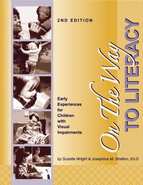- Home
-
Learn
- History of VI >
- Legislation & Laws >
- Vision Professionals >
-
VI Program Resources
>
- Program Printables
- Itinerant Teaching Tips
- Year at a Glance
- VI Program Handbook
- Caseload Analysis
- Organization & Time Management
- Professional Development
- Teacher Standards
- Professional Ethics
- Awards & Recognition
- APH Scholar Program
- Professional Organizations
- Certification Organizations
- Dealing with Challenges
- Professional Publications >
- Relatable Books for All Ages >
- Family Resources >
- Plan
- Basics
-
Teach
- Teaching Strategies >
-
Compensatory Skills Instruction
>
-
Social Skills
>
-
Self Determination
>
- Body Image & Acceptance
- Making Personal Goals
- My Vision Presentation
- My Self-Description
- Create a Personal Data Sheet
- Disclosure Decision
- Disability Statement
- Requesting Help
- Fighting Fears
- My Circle of Support
- Personal Responsibility
- Advocate for Safe Enviroments
- Having Picture Taken
- Coping with Change
- Aging Eyes
- Physical Characteristics
- Political Activism
- Laws Regarding Persons with Disabilities
-
Sensory Efficiency
>
-
Independent Living
>
- Orientation & Mobility Instruction >
- Recreation & Leisure >
-
Career & Vocation
>
-
Grow
- Complete Set Bonus >
-
Recorded Presentations
>
- Webinar: Tips for Being a "Physically Fit" TVI
- Webinar: The Art of Teaching the ECC
- Webinar: Virtual & F2F Strategies
- Webinar: Foundations of Teaching the ECC in the Age of Virtual Instruction
- Webinar: Itinerant Teaching Strategies
- Webinar: Using Themes to Teach the ECC
- Webinar: Conducting a FVLMA
- Webinar: Selecting the Right AT
- Webinar: Developing SMARTER Goals
- Webinar: Determining Service Intensity Using the VISSIT
- Webinar: Activities to Teach the ECC
- Webinar: Accessible Content for BLVI
- Webinar: Accommodations for VI
- Webinar: MIMO Strategies & Activities
- Webinar: SIDPID Strategies & Activities
- Webinar: Standard Course of Study Strategies & Activities
- Webinar: Job Tasks for Job, Career & Life
- Shop
- Jobs
Early Intervention ServicesBy: Carmen Willings
teachingvisuallyimpaired.com Updated November 4, 2017 Early Intervention services are similar to school-age special education services but are for children ages birth through two. Early Intervention is a system of services and supports designed to help families care for and encourage the development of their infants and toddlers (birth to 36 months of age) with disabilities. Family participation in Early Intervention is voluntary. Like school aged services, Early Intervention services begin with an assessment to determine the child's needs and what type of help the parent or caregiver wants for the child. The intervention can take place in an Early Intervention center, within a daycare setting, or at the child's home. It is important for a Teacher of Students with Visual Impairments to be a member of the intervention team. Unfortunately, not all cities, or even states, have Early Intervention programs that include Teachers of the Visually Impaired.
Early Intervention is a critical service for students with visual impairments as it builds a foundation for further learning. As described in the Guiding Principles page of this site, a visual impairment limits the opportunities a child has to learn about their world. They need unique instruction, modeling, and hands-on opportunities to make sense of their world. Many of the suggestions throughout this site are applicable to infants and toddlers. I have summarized here some of the key points that are particularly important to keep in mind when working with young children who are visually impaired. Developmental MilestonesA child with a visual impairment may achieve developmental milestones at a slower pace than their sited peers. This is not related to a lack of cognitive skills as a visual impairment is a sensory loss and is not related to cognition. That being said, it is common for children to have disabilities in addition to vision loss. Some of the items on typical child development scales are not going to be applicable to a child who is blind or visually impaired. Vision is the primary sense that infants and toddlers use to organize and learn about the world. Without continuous feedback from vision, information about social interactions and the physical environment is difficult to understand and put together.
Provide a Variety of ExperiencesInfants who are blind cannot observe the actions of others or see objects and materials around them. Even babies with some usable vision will have difficulty making sense of the limited visual information they are receiving. Additionally, they are not able to see the effects of their own actions on objects, that the object continues to exist when out of reach (object permanence), or observe how others interact with the object. As stated throughout this site, providing children with a variety of hands-on experiences that with real objects will help the child learn best. Actively modeling play activities for the child, participating in everyday experiences with the child and explaining daily events will enable the child to learn about people, objects and events.
The child will learn new skills best by doing them with you. Wearing the baby in a front pack or a sling, and talking to the baby about what you are doing as you prepare a meal or do chores will help the baby make connections about the world. As the child gets older, allow the child to feel the spatula or touch the pan before you use it. Let the child be a part of the experience. Naturally, find a balance between encouraging touch and exploration and keep the child safe! By allowing the child to participate, you will help the child understand the process. Also, by teaching within the context of natural activity, the experience will be more meaningful. Provide Tactually Interesting Toys & MaterialsMany commercially available toys for infants and toddlers that are found in stores are very similar in their feel. Although they may make a variety of sounds, the material is a hard plastic or within a fuzzy stuffed animal. An effort should be made to find or adapt toys to add variety to what the child is able to feel as well as hear. Look for unbreakable toys that have interesting textures, weights, and temperatures. If a child has some vision, look for toys and materials with high contrast that will make it easier to see. Playing with real objects provides the child with various textures but also provides them with information about their world.
Exposing the child to a variety of textures will not only lay the foundation for braille but will motivate the child to explore and begin making comparisons. Children who are blind or visually impaired can frequently be sensitive to different textures and temperatures. Exposing the child to various textures and temperatures can help the child be more accepting of them. This is applicable for foods as well. Be sure to place toys and objects that make a sound near the child's hands so he will learn to reach for things.
Reduce Auditory DistractionsBe aware of auditory distractions. It is ideal to not have the television or radio on nonstop or loud as the child will not be able to focus on other sounds and language spoken by people in the room.
Talk to the ChildTalk to the child about what is happening. Find a balance between verbal descriptions and incessant talking. Provide short, clear descriptions of daily events and activities. Be sure to let the child know when you leave the room, and let him know when you return. Be sure to talk to the child about what you are going to do prior to doing it. For example, tell the child that you are going to wipe his nose prior to wiping it.
SiblingsProvide siblings a role in caring for their brother or sister. Although they shouldn't be forced, older children may enjoy helping the child practice activities suggested by teachers or therapists.
Create Consistent Routines & TransitionsCreating a consistent routine will help the child learn to anticipate events. When there is predictability and consistency in the schedule, the child will find comfort by being able to anticipate what is going to happen next. Prepare the child for each transition. If the child does not yet understand words/language, use an object, or touch cue, associated with the next activity to prepare them for what will happen next. For example, place the diaper in the child's hand prior to a diaper change.
Encourage the child who is visually impaired/Blind to moveStudents with significant visual impairments may need the motivation to move and explore objects outside of their immediate reach. The student may not be motivated to explore the world without seeing things to entice them. It may be tempting to bring everything to the student, but this will prevent the student from discovering things and the student may become dependent on others bringing the world to them. The student must be taught to move confidently and independently in order to explore and learn from their world. Encourage the student to use any remaining vision but to also use their other senses to make sense of their world. Encourage the student to learn by listening, touching along with using their sense of smell.
Encourage the child to hold his head up and reach toward objects in order to learn to walk and to explore their world. You can do this by helping the child understand his body and where it is in relation to other things. This will lay foundations for Orientation and Mobility skills. Placing wrist rattles on ankles and wrists will help give the child a sense of where his hands and feet are. Place sound sources throughout the house (or daycare center) to help the child orient himself within the home. Place wind chimes on the front/back door or bells on the doorknobs. Create as many places as possible for the child to explore safely. If the child is mobile, and keep the floors uncluttered, doors fully opened or closed.
Foster IndependenceMany well-intentioned parents and caregivers will feel tempted to do everything for the child who is blind or visually impaired. It can be easier to do it yourself because it takes the child much longer to complete the task. It is, however, in the child's best interest to not give in to this temptation. Teach the child new skills by completing tasks with the child, not for the child. Although it may take longer to acquire skills, with repeated experience and extra time, the child will learn to become more independent.
More Articles Related to Early InterventionMore Resources:
On the Way to Literacy Handbook, 2nd edition. American Printing House for the Blind. 2007. This revised version, available from APH with quota funds, includes comprehensive information about emergent literacy. It brings together material from a variety of sources to give teachers and parents information about how literacy develops for a young child with a visual impairment, from birth until the child begins to read and write. It discusses areas of development that form a foundation for literacy and everyday activities that support a child’s learning in these areas.
Public Law 99-457, the Early Intervention Program for Infants and Toddlers with Disabilities Act, established the initial federal funding and guidelines for Early Intervention services. Enacted in 1986, PL 99-457 became what is now known as Part C of the Individuals with Disabilities Education Act (IDEA). |
History of vi
Visual Impairments
Vi organizations & Agencies
VI book resources
VI Professionals
Professionalism
Instructional Planning
Professional Publications
Educational Programming
Individual Learning Differences
referrals
Medical vision exams
fvlma
additional evaluations
service planning
writing goals
compensatory skills
Guiding Principles Functional Skills Community Based Experiences Concepts to Teach Access to Instruction Organization & Study Skills Time Management Virtual Instruction Movies & Assemblies Lectures & Instruction Board Work (Chalk, White, etc.) Daily Schedule Morning Meeting Weather Check Dramatic Play Blocks Numbers & Counting Cranmer Abacus Instruction Algebra Geometry & Spatial Sense Measurement & Data Early Literacy Experiences Create Tactual Books Reading Instruction Reading Efficiency Science Adaptations Social Studies Adaptations Communication Modes Accessible Educational Materials Individual Schedules & Communication Cards Adjust Lighting Large Print Optical Devices for Near Optical Devices for Distance Optical Device Use Photocopying Font Legibility Increase Contrast Pictures & Worksheets Keyboarding Instruction Word Processing and Shortcuts Navigate Computer w/o a Mouse Braille Code Braille Instruction Braille Instruction Materials Writing Braille Summer Reading (braille) Signature & Handwriting Nemeth Braille Code Tactile Graphics Guidelines Creating Tactile Graphics Tactile Graphics Instruction Teacher Made Materials Labeling System assistive technology
Overview of Assistive Technology VI AT Resources Non-Optical Low Vision Devices Video Magnifiers Video Magnifier Instruction Screen Enlargement & Readers Low/Med. Tech Tactual Devices Notetaker Instruction Braillewriter Repair Tactile Graphics Technology Braille Technology Auditory Access Devices Accessing Audio Books iPads as Instructional Tools Making iOS Device Accessible iOS Accessibility Resources VoiceOver Apps for VI Note Taking apps Apps for Accessing Books Identification Apps Navigation & Location Apps Braille Apps Magnifier Apps Sound Making Apps Cause & Effect Apps Vision Skills Apps Apps for Early Learning Read to Me Story Apps Apps for Communication Android Apps for VI sensory efficiency
Sensory Input Encourage Use of Vision Sensory Area & Rooms Lightbox Use Sensory Activities for Students with Multiple Disabilities Sensory Tables Visual Efficiency Skills Visual Attend and Scan Activities Visual Tracking Activities Visual Discrimination Activities Visual Motor Activities Tactual Readiness Developing Skillful Hands Auditory Readiness Listening Skill Instruction independent living
orientation & Mobility
career education
recreation & Leisure
self determination
|
|
Teaching Students with Visual Impairments LLC
All Rights Reserved |
- Home
-
Learn
- History of VI >
- Legislation & Laws >
- Vision Professionals >
-
VI Program Resources
>
- Program Printables
- Itinerant Teaching Tips
- Year at a Glance
- VI Program Handbook
- Caseload Analysis
- Organization & Time Management
- Professional Development
- Teacher Standards
- Professional Ethics
- Awards & Recognition
- APH Scholar Program
- Professional Organizations
- Certification Organizations
- Dealing with Challenges
- Professional Publications >
- Relatable Books for All Ages >
- Family Resources >
- Plan
- Basics
-
Teach
- Teaching Strategies >
-
Compensatory Skills Instruction
>
-
Social Skills
>
-
Self Determination
>
- Body Image & Acceptance
- Making Personal Goals
- My Vision Presentation
- My Self-Description
- Create a Personal Data Sheet
- Disclosure Decision
- Disability Statement
- Requesting Help
- Fighting Fears
- My Circle of Support
- Personal Responsibility
- Advocate for Safe Enviroments
- Having Picture Taken
- Coping with Change
- Aging Eyes
- Physical Characteristics
- Political Activism
- Laws Regarding Persons with Disabilities
-
Sensory Efficiency
>
-
Independent Living
>
- Orientation & Mobility Instruction >
- Recreation & Leisure >
-
Career & Vocation
>
-
Grow
- Complete Set Bonus >
-
Recorded Presentations
>
- Webinar: Tips for Being a "Physically Fit" TVI
- Webinar: The Art of Teaching the ECC
- Webinar: Virtual & F2F Strategies
- Webinar: Foundations of Teaching the ECC in the Age of Virtual Instruction
- Webinar: Itinerant Teaching Strategies
- Webinar: Using Themes to Teach the ECC
- Webinar: Conducting a FVLMA
- Webinar: Selecting the Right AT
- Webinar: Developing SMARTER Goals
- Webinar: Determining Service Intensity Using the VISSIT
- Webinar: Activities to Teach the ECC
- Webinar: Accessible Content for BLVI
- Webinar: Accommodations for VI
- Webinar: MIMO Strategies & Activities
- Webinar: SIDPID Strategies & Activities
- Webinar: Standard Course of Study Strategies & Activities
- Webinar: Job Tasks for Job, Career & Life
- Shop
- Jobs

